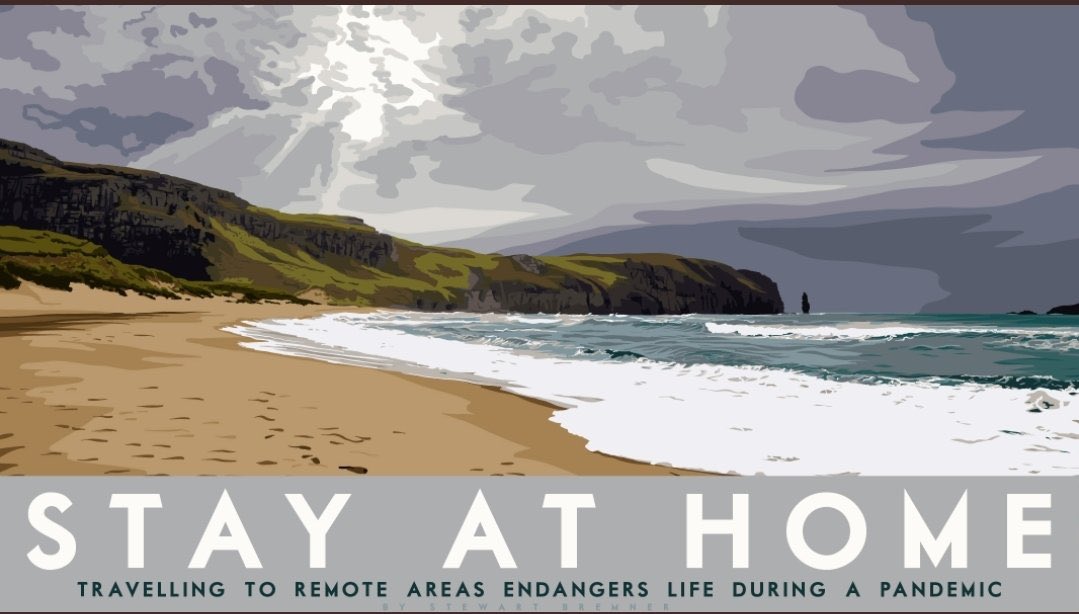Image Credit: Stewart Bremner, Indy Prints
The world is currently joined in a wave of lockdown measures to limit the general public’s freedom of movement: the most severe method to mitigate the spread of COVID-19. One of the core WHO messages during the COVID-19 global public health emergency has been a concept new to the general public: social distancing. This means only leaving the house for set essential reasons; avoiding group gatherings; minimising physical social contact; and keeping two metres, or six feet, away from others.
Despite global leaders and public health officials emphasising these social-distancing crisis communications messages at daily press briefings and in interviews, compliance has been very patchy. This is evident from the reported scenes last weekend from Australia’s Bondi Beach, Florida’s traditional Spring Break revellers, and campers heading to the Scottish Highlands. This has been a huge challenge to the most seasoned crisis communications professionals. Why do some people need to be ‘instructed’ to comply, rather than simply asked to follow official guidance?
Compliance of any regulation, law, policy or guidelines is driven by attitude to risk. Placing this in the context of the social-distancing guidance, how people respond to these messages is driven by four key factors:
Individual or group risk appetite
So, what is risk appetite? Why is it important in crisis management planning and response, specifically in the context of the current crisis? I asked Clive Thompson CFIRM, Deputy Chair at the Institute of Risk Management to help explain:
“Put simply, risk appetite is like any appetite - it's how much of a risk you want to take on a single or set of decisions or actions.
“The risk appetite of individuals to COVID-19 is driven by their knowledge of the impact and possible outcomes. Governmental risk appetite is driven with full awareness or knowledge of possible outcomes overlaid with political judgement as to what is acceptable socially.”
It is at this point we can begin to see the divergence of appetite: individuals and governments seek different outcomes. Limits to or loss of liberty versus saving lives and supporting public services. At one end of the spectrum we have individuals with a high risk appetite, and the other, governments managing the crisis and doing their best to mitigate all risks to spare healthcare systems and public services from being overwhelmed.
Group (family or organisation) risk culture
The next key factor in this crisis communications campaign challenge is the risk culture in society. Risk culture is more about awareness of the concept of risk. Clive elaborates further:
“Risk culture at a social level takes account of this judgement about ‘acceptability’. In mature democracies with considerable resources to deal with a pandemic, governments everywhere are wrestling with what is ‘acceptable’ in terms of possible outcomes.”
It is fair to say we have seen very few major disruptions like this to our daily lives. In the context of the current crisis, we are now moving from a low to high risk culture in a very short space of time: a huge leap of mindset and change of thinking for many.
Individual responsibility for consequential risk
This mindset change involves not only taking individual responsibility, but also considering the consequential risk of the decisions made when it comes to assessing if a journey is necessary. Do you really need to go out for fresh strawberries, can you work from home or can you rearrange that social gathering to better times?
In the context of COVID-19, this means the individual decision made can affect many, many others. This point has been borne out in numerous public information infographics and videos that illustrate how one person can pass on the virus to tens of thousands of others. Achieving this mindset change has been extremely challenging with some members of society. Their risk assessment focuses on their own risk, rather than the consequential risk of being a potential ‘super-spreader’. Bluntly speaking, many remain selfish, don’t care about others and their decisions are driven by individualism.
A concept counter-intuitive to the socially driven human race
The final challenge in communicating the social-distancing message and drilling down compliance in a record timescale is the simplest one of all to understand. We are asking millions to behave in a way that they are simply not used to. It is counter-intuitive to our socially driven daily lives: hugging, catching up with friends over a drink, attending a gym class, or going to work.
Both individual behaviours and regular routines have suddenly been paused. This would have been unthinkable just a few weeks ago. I heard via a friend about a woman she knew who told her last week that she couldn’t comply with the social-distancing guidelines as “I have to leave the house to meet my friends for coffee.” Then, within a few short days, one of her friends succumbed to COVID-19. She immediately self-isolated. Of course, this shouldn’t be what it takes to drive the message home.
To end on a more positive note, here is a more public example of the difficulties of both announcing and implementing the new social-distancing rules: Dutch Prime Minister Mark Rutt declaring his country’s ‘no handshake’ policy on 10 March.
It isn't easy communicating new concepts and behaviour change in highly unusual circumstances, but remembering these four principles will help. Stay safe everyone.
Useful Links
Institute of Risk Management: https://www.theirm.org
Risk Managers that study or train with the IRM will be familiar with the principles, tools and techniques of risk management, business continuity and crisis response that can be deployed to help organisations prepare and respond to situations like this.
Government of Canada social-distancing guidelines: https://www.canada.ca/en/public-health/services/publications/diseases-conditions/social-distancing.html
Government of Sri Lanka explaining social distancing and consequential risks: https://www.youtube.com/watch?v=gXkCLWn9QF
Indy Prints: https://indy-prints.com/collections/giclee-prints

